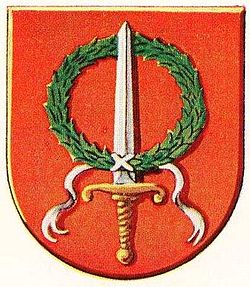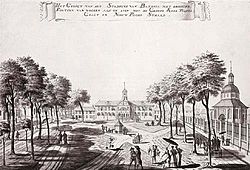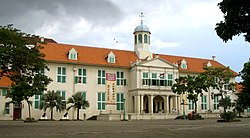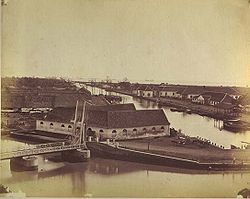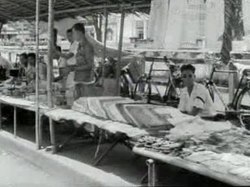Batavia (Dutch East Indies)
Batavia was from 1619 to 1799 the headquarters of the Dutch East India Company in Asia and until the independence of Indonesia in the 1940s, the capital of the Dutch East Indies . Since then it has been the capital of Indonesia under the name Jakarta . The city is located on the north coast of Java , in a well-protected bay, in a flat and in some places swampy environment, crossed by canals and rivers.
Batavia consisted of an old town in the deepest and unhealthy part and a slightly higher new town in the modern style. Governor General Herman Willem Daendels was the initiator of the expansion in the 19th century.
At the time of the Dutch East India Company, Batavia had 30,000 to 50,000 inhabitants. In the second half of the 19th century it grew into a city with 800,000 inhabitants. At the end of the Dutch colonial era, the million mark was reached. In 1905 the city numbered 9,000 Europeans, including the legally equal "Indo-Europeans". The Europeans and mestizos made up one percent of the total population. The region had 2.1 million inhabitants, of whom 14,000 were Europeans, 93,000 were Chinese and 2,800 were Arabs.
In the past, Batavia had two epithets: "The churchyard of Europe", because of the high mortality rate of newcomers in the era of the Dutch East India Company, and "Queen of the East" because of its urban beauty.
history
Batavia emerged as a port city during the times of the Hindu Kingdom of Sunda (Pajajaran) in the 14th century and was originally called Sunda Kelapa (according to the old spelling Soenda Kelapa). The city was conquered by Fatahillah from the Sultanate of Demak on June 22, 1527, which is considered to be the official founding date of the city. He named the city Jayakarta , also written Djajakarta or Jacatra , which means "glorious victory".
In November 1610, Jacques L'Hermite signed a treaty with the regent who was dependent on the Sultanate of Bantam , Prince Jayawikarta, who was represented because of his young age by the crafty Pangeran Aria Ranamanggala. The first Governor-General in the Dutch East Indies , Pieter Both , did not receive approval for the construction of a fort in 1611, but probably for a trading post , which in the Chinese quarter on the banks of Tjiliwan was built. In 1614 JP Coen was appointed director of all factories. In 1618 he was appointed governor general. Another reason was the competition and the older rights of the Fujian Chinese in Bantam. In November he began to expand the fort without consent. In order to keep things in balance, the English also received consent to strengthen a trading post. As a result, the English trading post was devastated on December 24th. On January 2, 1619 there was a meeting off the Javanese coast with the English under Sir Thomas Dale, which remained fruitless. Coen then secretly sailed to the Moluccas to get help from Herman van Speult and Adriaen Maertensz. Block .
In the meantime, work was carried out on the fort day and night in Batavia under the direction of Pieter van den Broecke . They were taken hostage by the Javanese and surrendered on February 1, 1619. Broecke also signed a treaty with the English and the Sultan. A dead end was created, which was broken on May 30, 1619 by Coen, who came with 17 ships. The Bantammers were driven out, all 15 English ships withdrew, Jacatra was burned to the ground and the population was driven out. There was almost nothing left. The prince retreated inland and Coen came to an agreement with Bantam after a blockade of the port. The Dutch East India Company (VOC) became ruler of the entire region.
The fort had been named Batavia on March 12th by the commander van Raay. Coen, on the other hand, wanted to name the branch Nieuw-Hoorn (after his birthplace Hoorn ), but did not get approval from Heren XVII, the directors of the VOC.
On the east side of the Ciliwung a square castle was built with large protruding bastions at the corners. Javans have been undesirable since they were founded in 1619 because they feared renewed uprisings. Coen left Willem Ysbrandsz. Bontekoe kidnap a thousand Chinese from Macau and take them to Batavia. Only a few dozen survived the ordeal. In 1621 eight hundred Bandanese, the only survivors of the 15,000 inhabitants, were brought to Batavia; about 600 arrived alive.
After a Javanese siege in August 1628, a fortress was built according to the ideas valid at the time, which were mainly represented by Simon Stevin . Jacques Specx expanded Batavia further; the so-called Oosterstad (Oststadt) surrounded by a city canal. Around 1646 a typical Dutch canal system was laid out with four canals; the ciliwung was canalized. For fear of an uprising, the city walls were laid out in such a way that they could also see the streets of the city.
In 1656 all Javans had to settle outside the walls as a result of hostilities with Bantam. After peace was made with Bantam in 1659, the city was able to grow. More and more country houses and arbors were built. From 1667 bamboo houses were banned in the city, as was the keeping of cattle. Because the city attracted many people, many suburbs emerged outside the city walls.
The outer area remained unsafe for the non-native population for a long time. Only when peace was again made with Bantam in 1684 did the cultivation of the Preanger (surrounding area) advance. The area around Batavia was slowly transformed into cultivated land. After many country houses were fortified, agriculture also made progress. The Chinese in particular made the start and grew sugar cane, from which sugar and arrack were made.
Large-scale logging of wood, which was needed for refining sugar, among other things, led to erosion around Batavia. This silted up the city's canals. Despite dredging work, the city canals became smelly mud holes and the fish ponds in front of the city became breeding grounds for the malaria mosquito. In the 18th century, Batavia was hit by numerous epidemics, and those who could afford it moved to higher areas. Eventually the old city was demolished around 1810.
In the meantime a new center had formed some distance to the south, a residential area called Weltevreden . Here was also the enormous Koningsplein (Königsplatz), now called Medan Merdeka (Freedom Square).
population
Batavia was founded as a transshipment point and administrative center. The aim of the VOC was not to establish a settlement. Coen wanted a trading colony with loyal and hardworking residents who could be used for the production and delivery of food and for defense. However, the settlement of Dutch families did not succeed at first. The Dutch men fathered children with Asian women. Their children were called mestizos , later they became known as Indo-Europeans (Indian Dutch).
Because the VOC wanted to keep the entire trade in hand, the settlement of free citizens was repulsed as far as possible. Batavia was made unattractive to people who wanted to trade outside of the VOC.
The majority of the residents were of Asian descent. Many thousands of slaves were also imported from India and Arakan ( Burma ) . Later the slaves came from Bali and Celebes . To avoid riots, Javans were not kept as slaves.
The Chinese lured to Batavia (sometimes under duress) created a large Chinese population group, consisting of both merchants and workers. This group was very important for the development of the city.
There was also a large group of Mardijkers , Portuguese-speaking Asian Christians who had been kept as slaves by the Portuguese. These had been brought in by the VOC as prisoners of war in the many conflicts with the Portuguese. For a long time, up until the late 18th century, Mardijker's Portuguese was the dominant language in the city, ahead of Dutch and Malay. After that people from all parts of the archipelago lived in Batavia, as well as trading communities of Indian Muslims, Hindus and Malays. Initially all population groups lived together, but they quickly separated in different parts of the city.
In 1688 there was a complete separation from the local population. Each group had to settle in the surrounding areas in residential towns (kampongs) under their own heads. All residents were given a lead identity badge on which the affiliation to the appropriate population group was noted. They were not allowed to marry outside of their own population group without consent.
While the Chinese were considered the most trustworthy, they were the source of the most inconvenience. Chinese gangs made the surrounding area unsafe and invaded the city in 1740. When the Dutch found weapons in individual Chinese people in the city, it resulted in a slaughter known as the Chinese Murder. Later the Chinese got their own neighborhood in the south of the city and were allowed to live in the city again.
Townhouses and country houses

Batavia was in many ways a Dutch city. However, the houses were adapted to the Indonesian circumstances. There were overhanging roofs as protection from the sun and outbuildings for the slaves. The rich had large country estates built first in the Dutch and later in the Javanese style.
Women of Batavia
There were few Dutch women in Batavia. Men therefore often had contact with Asian women without marrying them, because they could then no longer return to the Netherlands. This created a mixed culture in Batavia ( Mestizo culture).
Sons often studied in Europe, daughters had to stay. They often married VOC employees at a very young age. Because the women stayed in Batavia all the time, they ran the social network. They were used to dealing with slaves and also spoke the local languages, especially Portuguese and Malay. If the men let their wives come from the Netherlands, the Asian women were cast out. Often they had to keep their distance from their children. These women were called "Snaar".
Splendor and pomp
The opulence of the upper class of Batavia led, at the instigation of the Heeren XVII, to the enactment of luxury laws to limit the display of wealth, which, however, had little success. In 1754, Governor General Jacob Mossel took up the matter with vigor. Each rank was prescribed how it could present itself. The size of the carriages, the number of horses in front of them, the jewels, the embroidery on the clothes and the like - everything was officially determined. Under the influence of the Batavian Republic's ideals of equality , these regulations were abolished in 1795.
slaves
Dutch and mestizo women were in the habit of being accompanied on the streets by large numbers of well-dressed slaves. This was also drastically limited by Mossel.
In the 18th century, more than 60% of the population were slaves. They mostly had household chores to do. The working and living conditions were generally appropriate. There were laws that protected them from being too rude on the part of their masters. Christian slaves were given freedom back after their master's death. Some managed to earn money by doing their own crafts or doing business in order to buy themselves out.
Slaves regularly fled to the surrounding area and made the area unsafe in large gangs.
Modern times (1880–1942)
Batavia has gone through as many developments as Dutch cities. When, at the end of the 19th century, technical progress with steamships and a shortened route through the Suez Canal brought the Dutch East Indies closer, the global demand for raw materials rose sharply and the monopoly of the Dutch Trading Company was given up as the successor to the United East India Company City itself strong. Thanks to the construction of the large port in Tjandjong Priok , Batavia became the engine of the colony. The city got its first railroad in 1873 (to Buitenzorg ) and in 1899 an electric tram. Four months ahead of the Dutch tram line Haarlem – Zandvoort, it was the first tram in the whole Kingdom of the Netherlands to be supplied by an overhead line.
Schools, hospitals, factories, trading company offices, and post offices were established throughout the city by 1900. At the same time, the arrival of Dutch people, the so-called totoks, followed, making the coexistence more and more like a Dutch city. Especially in the years 1920 to 1940, the population increased sharply due to the influx of rural populations. New quarters for the poorer Indonesians were created, as well as residential areas such as Menteng and Gondangdia. Shortly before the Second World War , around 50,000 people lived there. The old Batavia with its canals, which had previously been abandoned for the new Weltevreden district , now flourished again with returning trading companies. The advent of cars, much faster than in the Netherlands, resulted in the roads being paved. In a very short time the city changed outwardly, with the VOC shipyard, the VOC warehouses, the mansions and the old town house being preserved.
mayor
- GJ Bisschop (1916–1920)
- H. van Breen (1920–1920) provisionally
- A. Meijroos (1920-1933)
- EA Voorneman (1933-19 ??)
- A.Th. Boogaardt (provisional 1941)
- EA Voorneman (1941-1942)
- A.Th. Boogaardt (1945–1947)
Republic of Indonesia
Although the word Batavia is no longer used for what is now the capital of Indonesia, it lives on in Indonesia as Betawi , which reflects the local pronunciation and is used to denote the former population of Batavia and its language. The name is also still used locally, for example when naming Batavia Air , Café Batavia or Hotel Batavia.
In 2005 Jakarta was a city with 8.5 million inhabitants (the agglomeration counts 17 million).
Personalities from Batavia
- Rein van Bemmelen (1904-1983), geologist
- Ben Bot (* 1937), Dutch diplomat and minister
- Huibert Boumeester (1900-1959), rower
- Jeroen Brouwers (* 1940), journalist
- Gaston Feuilletau de Bruyn (1848–1902), Colonel of the Artillery
- Tonke Dragt (* 1930), writer for children and young people
- Attie Dyserinck (1876–1942), teacher, painter and composer
- Caro van Eyck (1915–1979), actress
- Sicco Ernst Willem Roorda van Eysinga (1825–1887), engineer, publicist and free thinker
- Charles Gairdner (1898–1983), British general and governor of Western Australia and Tasmania
- Hope Robert Mac Gillavry (1865–1951), Lieutenant General
- Jan Willem Hugo Lambach (1909–1972), natural scientist, engineer and aircraft manufacturer
- Jan Glastra van Loon (1920–2001), politician
- Boudewijn de Groot (born 1944), singer
- Hendrik Johan de Haas (1904–1945), sergeant major
- Hella Haasse (1918–2011), writer
- Dirk van Haren Noman (1854-1896), physician
- Michel van Hulten (* 1930), State Secretary
- Levinus Wilhelmus Christiaan Keuchenius (1822–1893), lawyer and politician
- Yvonne Keuls (* 1931), writer
- Taco Kuiper (1941–2004), investigative journalist and namesake of the Taco Kuiper Award
- Hugo Frank Lambach (1909–1972), engineer and aircraft manufacturer
- Peter Landberg (1891–1962), engineer
- Anja Latenstein van Voorst-Woldringh (* 1940), Mayor van Albrandswaard, Oud-Beijerland, and Rijnwoude
- Ton Lensink (1922–1997), actor
- Jeanne Merkus (1839–1897), adventurer
- Pieter Mijer (1812–1881), statesman
- Johannes Osten (1879–1965), fencer and vice admiral
- Rutger van Randwijck (* 1937), Attorney General
- Karel Justus Constant Rijnen, Major
- Eddy van der Roer (* 1946), footballer
- Arthur van Schendel (1874–1946), writer
- Carel Jan Schneider (1932–2011), writer
- Eric Schneider (* 1934), actor
- Rob Slotemaker (1929–1979), rally driver
- Francis Steinmetz (1914–2006), officer
- Joop van Tijn (1938–1997), journalist
- Frans Tutuhatunewa (1923–2016), President of the RMS
- Gilles Johannes Verstege, Lieutenant Colonel
- George Johan Albert Webb, captain
- Ilse Werner (1921–2005), actress
- Henri Gustave Verspyck (1855-1917), engineer
- Flip Winckel (1919–2009), Dutch resistance fighter in World War II
- Johan Lodewijk Leonard Marinus Wittich (1858–1941), first lieutenant
- Eddy de Neve (1885-1943), footballer
- Frans Hendrik Karel Zaalberg, founder of the Indo-Europeesch Verbond, journalist of the Bataviaasch Nieuwsblad
literature
- F. de Haan: Oud Batavia. Bataviaasch Genootschap van Kunsten en Wetenschappen 1919.
- JME Worms (Red.): Oriëntatiecursus cultuurwetenschappen. Java en de VOC. (Open Universiteit, Heerlen 1992), ISBN 90-358-1032-5 .
- Hendrik E. Niemeijer: Batavia. A colonial seed living in de zeventiende eeuw. Balans, 2005, ISBN 90-5018-723-4 .
- RPGA Voskuil: Batavia beeld van een stad. Asia Maior, Purmerend 1997, ISBN 90-74861-11-3 .
- ME de Vletter, RPGA Voskuil ea: Batavia / Djakarta / Jakarta Beeld van een metamorfose. Asia Maior, Purmerend 1997, ISBN 90-74861-09-1 .
Web links
Individual evidence
- ↑ Oosthoek's Geïllustreerde Encyclopaedie. (1917)
- ↑ Also called Widjaja krama.
- ↑ Jan Pietersz. Coen: Couste que couste on DBNL.org.
- ↑ De Erfenis van Jan Pieterszoon Coen Dagen en de Daden into service van Compagnie, 1602-1629 Open Access version via Utrecht University repository.
- ↑ L. Blussé, FJ. van Luyn: China en de Nederlanders. Geschiedenis van de Nederlandse-Chinese betrekkingen 1600–2007. Walburg Pers, cop., Zutphen 2008, ISBN 978-90-5730-545-0 , p. 36.
- ↑ Dutch (VOC) Conquest of Jakarta (Batavia) 1619. on Zum.de.
- ↑ VOC-kenniscentrum.nl
- ↑ Kitlv-journals.nl ( Memento from September 7, 2011 in the Internet Archive )
- ^ HT Colenbrander: Jan Pietersz. Coen. Levenbeschrijving. 1934, pp. 159-169.
- ↑ Batavia. on vocsite.nl.
- ^ FW Stapel: Gouverneurs-Generaal van Nederlandsch-Indië. 1941, p. 19.
- ↑ Later the plaque was replaced by a parchment.
- ↑ De feestelijke opening van het baanvak Dierentuin - Harmony of the Batavia Electric Trammaatschappij In: Bataviaasch Nieuwsblad. 1899, Vol. 14, No. 107, p. 1.
